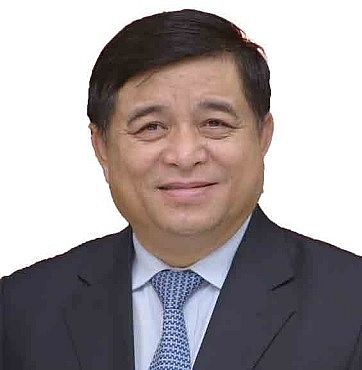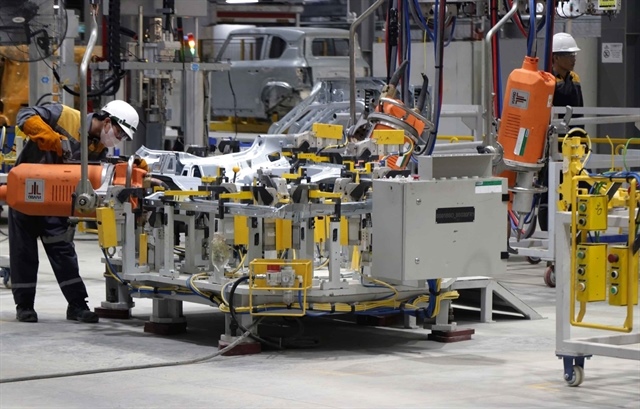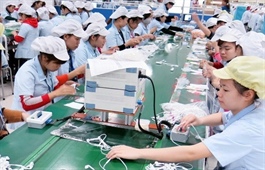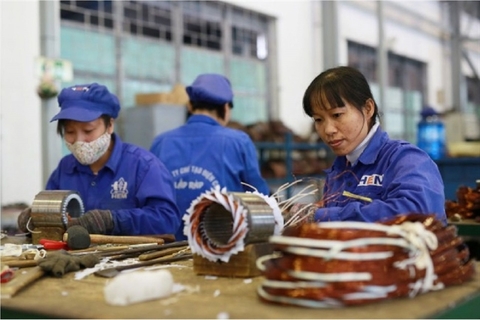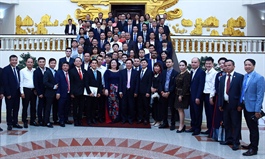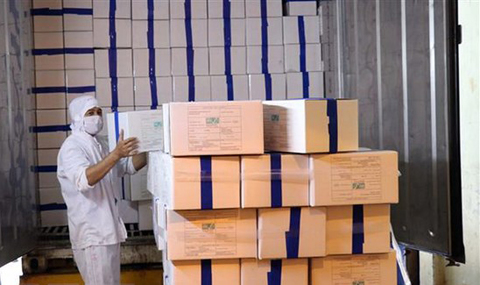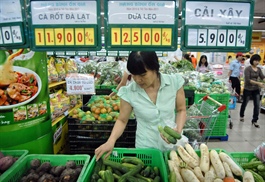VRDF highlights advantages of value chain development
VRDF highlights advantages of value chain development
Amid the heavy impact the pandemic has had so far on Vietnam’s economy, possible solutions to overcome the crisis and come out even stronger have been under discussion at this year’s Vietnam Reform and Development Forum. At the event, participants like the World Bank’s current vice president for the region highlighted enticing recipes for the continuation of Vietnam’s success story.

Domestic businesses are being urged to invest in new technologies and skills, photo Le Toan
|
In an even more pivotal role than 11 years ago, the World Bank’s current vice president for East Asia and Pacific Victoria Kwakwa attended last week’s annual Vietnam Reform and Development Forum (VRDF) in Hanoi.
|
Nguyen CHi Dung - Minister of Planning and Investment
The most important goal of VRDF this year was to provide inputs to help the country complete the draft strategy and orientation for national socioeconomic development for the period 2021-2030. Vietnam has been rising strongly and became a low-middle-income country in 2010. The current size of the economy has increased more than 40 times compared to 1990. Per capita income has increased from around $100 before 1990 to nearly $2,800. Thus, people’s quality of life has been significantly improved. Joining many new-generation free trade agreements, such as the EU-Vietnam one and the Comprehensive and Progressive Agreement for Trans-Pacific Partnership, the country has great potential to integrate and participate more deeply in the global production network and may choose quality foreign-invested projects to advance further up the ladder in global value chains. Vietnam is at an important point in transforming its rapid and sustainable development. The country’s potential and the new development landscape, especially with regards to the recovery after the pandemic and the Fourth Industrial Revolution, are creating favourable conditions for restructuring the nation amid the digital transformation and a shift towards fast, sustainable, and inclusive growth. |
Vietnam has been able to tell its development success story with the excellent results of the last three decades at the forum, showcasing its achievements in many areas such as economic growth, commerce, and human development.
However, “there is still considerable room” to continue to improve on global value chain development,” said Kwakwa at the VRDF, realising the long-term development goal of becoming a high-income country by 2045 and narrowing the gap with advanced countries that she considers “ambitious”.
At the forum, Kwakwa indicated that the country features an open economy but the level of its participation in the global and regional value chains is limited, even much lower than other ASEAN countries, such as Singapore, Thailand, Indonesia, Malaysia, and the Philippines. In 2018, Vietnam only generated $20.4 billion by participating in the global value chain, ranking 55th out of 174 countries. This figure is less than a quarter of the Philippines, which ranked 34th with $84.8 billion.
Kwakwa also explained that Vietnam’s participation in sophisticated and complex production processes remains low, while increasing participation in the global value chain could be a key factor that helps the country to boost productivity and growth.
The World Development Report 2020 also confirms that Vietnam’s participation in manufacturing and processing is limited. The report estimates that a 1-per-cent increase in global value chain participation would also increase per capita income by more than 1 per cent – which represents more than twice as much as traditional trade. Meanwhile, Thailand, Indonesia, and Malaysia have achieved the next two levels of complexity in the global value chain, advanced manufacturing and services.
Jonathan Pincus, senior consultant of the United Nations Development Programme, said Vietnam is facing difficulties in taking advantage of and participating in global networks to increase value and further develop the capacity of domestic enterprises. Moreover, the transition from a labour-surplus country to an economy with advanced technology is fraught with risks.
“Advances in automation could narrow the window available to Vietnam to move from assembly operations to more sophisticated segments of the value chain,” said Pincus.
Up until now, the growth of industrial labour productivity was rapid in the early stages of the country’s reform process but halted after the implementation of trade reforms that left upstream producers in the country facing competition from abroad. During the global financial crisis, the industrial productivity growth rate averaged 1.8 per cent per year.
Increasing depth in industrial production requires incentives for domestic enterprises to invest in new tech and skills. Pincus suggested that the government must think creatively about the tools that can be used to boost domestic investment and strengthen its position with its signed bilateral and multilateral agreements.
“Vietnam needs to resist the temptation to become more protectionist – in fact, quite the reverse, we believe that Vietnam should continue to ease entry and operational foreign direct investment (FDI) restrictions,” Pincus advised.
Baking success
At the VRDF, Kwakwa of the World Bank presented her special “mooncake” recipe for a successful development strategy, referring to it as the PIE recipe. In which, P stands for the private economic sector that could be closely linked to FDI, I for effective institutions, and E being the quality of education.
With this recipe for success, Kwakwa emphasised Vietnam’s current opportunities but also advised that the nation should not forget about decent preparations for its economic recovery after the pandemic as well as other chances on the horizon.
In the short term, Kwakwa said, the diversification of multinational companies depends on the recovery prospects of alternative manufacturing facilities. “While the traditional instruments of national innovation policy are no longer available, the government must think creatively about the tools at its disposal to promote domestic investment and upgrading within the confines of existing agreements,” she said.
In the medium term, it may be wise to prepare well for the “new normal” of value chains, as supply chains cannot be established overnight and companies still must go through a costly and time-consuming relocation process.
To do this, Vietnam may consider building a strategy to actively attract FDI from China using trade agreements, investment protection, and special incentives. Vietnam can also improve FDI leverage and strengthen linkages between foreign-invested and domestic enterprises. Additionally, the government can also re-examine its strategy for science, technology, and innovation.
In the long term, the consensus at the VRDF showed that Vietnam needs to close its productivity gap and move towards raising its limits. Average labour productivity in developing economies, like Vietnam, is less than a fifth of the level of advanced countries. Experience has shown that only economies of high educational and institutional quality can further push their boundaries.
Staying focused
Kwakwa also said that Vietnam needs to emphasise skill development and R&D capacity building as well as make significant changes in institutional reform. In skill development, it would be important to focus on those that increase participation in the value chain and lift the current limits of the manufacturing sector and elevate it to advanced services. In addition, the World Bank’s vice president for the region said that the country needs to pay due attention to R&D and the protection of intellectual property rights to prepare for a gradual transition to innovation activities, which represents the ultimate level of participation in the global value chain.
But to ensure inclusive development, Kwakwa said that Vietnam needs to manage disruptions in the labour market well, which will be an inevitable consequence of technological development associated with emerging automation. For example, new technologies can lead to more unsafe and precarious work placements, so legal, tax, and traditional social security reforms will be needed to strengthen the rights of workers.
Moreover, rapid technological change may also contribute to wage inequality between workers, employees, and business owners, so the government may use progressive tax policies to ensure that victories gained from new technologies such as AI are shared more widely and equally.
Previously, Kwakwa was the World Bank’s country director for Vietnam, overseeing a multibillion-dollar lending portfolio. In her current function as vice president for East Asia and Pacific, she oversees a portfolio of more than $32 billion in loans, grants, credits, and trust funds across 23 countries in the region.
|
Five major developments in the global economy - The pandemic magnifies ongoing trends in trade growth, GDP, and productivity; - Main sources of development capital, such as foreign direct investment, indirect investment, and remittances, have all decreased significantly; - With a slower flow of people, trade, and capital, the pandemic has also been aggravating the trend of protectionism; - The global production network is being broken up on an unprecedented scale; and - Increased automation and a retreat from global value chains are becoming visible. |
|
Lesley Miller - Deputy representative, UNICEF Vietnam
Developing the education sector is crucial in helping Vietnam achieve mid- and long-term growth targets because it will create a high-quality workforce for the country. We can’t wait until tertiary education – we need to start when they’re very young, to teach them new skills, new mindsets, and new approaches from the time they are very young. Investing for digital connectivity in education is also important. During social isolation, many children in the world didn’t have access to the internet or other digital devices to continue their studies. However, Vietnam has the capability to solve this problem. Every school in the country should be connected to the internet and every child should learn digital skills. UNICEF is already working with the Ministry of Education and Training on that. In the medium or even shorter term, that can be a solution to lift everyone’s digital skills up. Pierre-Jean Malgouyres - General director, Archetype Group
Vietnam is truly a remarkable country, achieving what it sets its mind to. Despite the pandemic, Vietnam has managed to control the situation to ensure the safety of its people. As in the past, the Vietnamese people are determined to act together in face of adversity. The Vietnamese economy grew rapidly in recent years and is poised for strong growth despite the pandemic. But as we saw how the pandemic hit all sectors, we all need to contribute to a steady rebuilding so that we will provide continuity and stability for the country. The construction industry has grown alongside Vietnam’s success, but all stakeholders should commit to infrastructure development plans that are sound and responsible. We should create structures by processes which are environmentally responsible and resource-efficient, focusing on sustainable green building designs. Marcel Reymond - Head of Cooperation, Swiss Embassy in Vietnam
COVID-19 has been a real test of economic resilience. Vietnam stands out not only by containing the outbreak successfully but also by becoming one of the handful of privileged economies achieving GDP growth in 2020. To sustain long-term economic growth, solidifying fundamentals is central. The financial sector and public finance management must be strengthened. Accelerating key reforms is equally important. Reforms should be geared towards incentives to motivate innovations and digitalisation as they are the drivers of corporate productivity and competitiveness. The Swiss State Secretariat for Economic Affairs has been providing holistic technical assistance to Vietnam to grow sustainably, and Switzerland will continue supporting Vietnam to create a conducive climate for the private sector. David Harrison - Partner, Mayer Brown Vietnam
Portfolio company preservation is now the top short-term priority for international private equity investors. This goes beyond basic survival as private equity investors want to ensure that their portfolio companies are competitively positioned when normalcy resumes. Investors will look to government economic stimulus packages to support private businesses in the four key areas of wage subsidies and employment, tax relief, industry-specific relief, and liquidity. Vietnam should consider incorporating programmes similar to those in Japan into its COVID-19 response, along with its other strategies. The quality of the Vietnamese government’s response to the crisis in the eyes of international investors will leave an imprint beyond the pandemic, influencing confidence levels in Vietnam’s leadership and the country’s ability to attract investment. Adam Sitkoff - Executive director, American Chamber of Commerce in Hanoi
Vietnam’s early and government action, and widespread public compliance has helped to mitigate the damage from this terrible virus. This success enabled a fast start on the path to economic recovery and as companies continue adjusting global supply chains, the government’s effective response to the pandemic will further boost Vietnam’s status as an attractive destination for investment. Vietnam can accelerate economic recovery by continuing infrastructure development, approving and expediting long-awaited investment projects. Improving waste management, reducing carbon emissions in Vietnam by accelerating the use of clean energy, clean vehicles, clean agriculture, and reducing the inefficiency and waste of energy will help build a stronger circular economy and will spur job creation. Alexander Gold - Chairman, Bankograph Financial Group
The Vietnamese government has chosen the right path to support the financial ecosystem and digital transformation in banking and fintech to widen financial inclusion and credit availability for micro- to medium-sized businesses. Modern technology has enabled customer assessment processes to include large amounts of non-financial data points into the predictive modelling of customer behaviour. This will accelerate financial inclusivity and reduce cost of finance, in turn boosting economic growth and promoting an inclusive, sustainable recovery. Implementing government financial support in the form of handouts is a costly exercise and may not be the right path. Micro- to medium-sized businesses form the economic backbone of the Vietnamese economy and should be supported in mounting their own recovery via access to low-cost funding, instead of one-off support payments. Alain Cany - Country chairman, Jardine Matheson Vietnam
Vietnam is achieving excellent results against the pandemic and should benefit with a V-shaped economic recovery as soon as the crisis is over, which should boost new foreign investments. One of the biggest challenges in the coming years for sustainable development remains in developing renewable energy at a fast pace and avoiding dependence on coal. In 2019 Vietnam put nearly 5,000MW of new power generation sources into operation – all generated from renewable clean and locally available energy sources. Vietnam achieved this in less than two years in less-developed provinces such as Ninh Thuan, Binh Thuan, and Tay Ninh. Resolution No.55-NQ/TW made it clear that Vietnam should prioritise renewable energies in the development of its energy plan for the coming years. Vu Minh Anh - Managing director, Terraverde Travel
The impact of COVID-19 on tourism enterprises has been immediate and significant compared to other industries. Most workers in these industries have been laid off or work on a salary that is too low to survive. Immediate financial support by the government or at least facilitated access to government-backed zero per cent interest rate credit is needed to help the industry survive. It would be wise to spend money now rather later when the economic impact of unemployment and rising social insurance costs has become more severe as the multiplication effect of the tourism industry also works in reverse. The pandemic is also an opportunity to rigorously reconsider development strategies and business models. Swift recovery of the world’s largest industry requires timely, bold and, in particular, coordinated policy efforts. Marek E. Forysiak - Chairman, SmartPay
As the Vietnamese economy continues to recover, the short-term opportunities will be significant and that will largely be driven by two factors. Firstly, the initial disruption has been caused by COVID-19 and not from an over-heated market, and the country took deliberate steps to protect its people, who also played a crucial role. This also means that the market demand has only continued to build during this period of uncertainty. As the potential threat of a second and third wave passes, there will be an extremely rapid recovery and even further acceleration. Secondly, this pandemic has demonstrated how efficient everyone can become from the usage of technology and, in particular, technology that improves both safety and security while also enabling more access to financial services. Vo Son - Deputy general director, F.L.D Vietnam Co., Ltd.
Our company has been able to operate despite the pandemic. That is because we have often ensured sufficient stock of materials from six months to a year, although the health crisis has resulted in late arrival of input materials. Due to a reduction in export order intake, the company has shifted into producing items serving the domestic market and making face masks with competitive pricing to support customers. Our company has properly adhered to instructions from the government for pandemic prevention, especially with the current growing complications, such as having a specific desk for health declarations and informing labourers on the latest instructions of authorities from central to grassroots levels to ensure accomplishment of the dual tasks of pandemic containment and pushing up production growth. |


